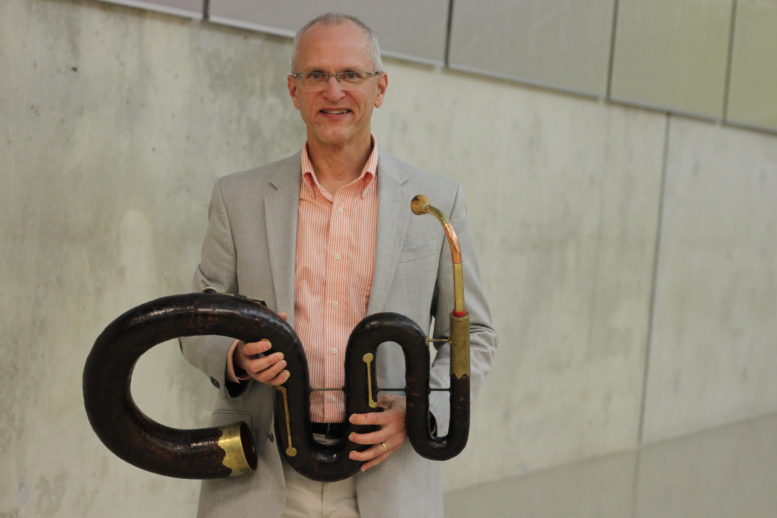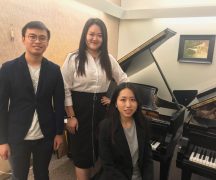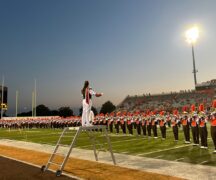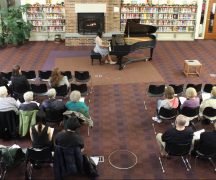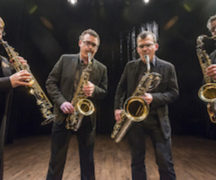By DAVID DUPONT
BG Independent News
After two hours of discussing the fine points of trombone playing – articulation, dynamics and the like, Doug Yeo left the student trombonists at Bowling Green State University with message.
“We live in a messed up world,” the visiting artist said. All they had to do was look out the door to see that. “What you do with trombones … matters.”
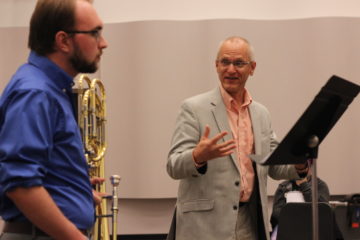
Doug Yeo (right) works with trombonist Jeff Hlutke during master class.
When people come to a concert, whether a student recital or a performance by a major symphony orchestra, the performer doesn’t know what brings them to listen. They may have just lost their job or a loved one. They might have just gotten engaged.
“You don’t know what their story is, but you’re playing for them and what you play can change their lives. They’re giving you something they’ll never have back, their time.”
And it’s up to the musician to make that time they spend together worthwhile.
“What you do,” Yeo said, “really, really, really matters. … I’ve been to concerts, and my life has changed.” That’s not just hearing star soloists, sometimes it has been a recital by one of his own students.
Yeo has been making a difference for listeners for decades. That included 27 years as the bass trombonist for the Boston Symphony Orchestra.
Since 1994, though, he has also performed on the serpent, a musical instrument dating by to the 16th century, and prominent through the 19th in military bands.
His visit to BGSU s to mark the donation and renovation of a serpent given to the College of Musical Arts by Glenn Varney, a professor emeritus of marketing. The serpent had belonged to his wife, Ruth, having been passed down to her by her grandparents.
The visit will culminate Thursday with The Ruth P. Varney Serpent: A Conversation and Concert Led by Douglas Yeo at 8 p.m. in Bryan Recital Hall in the Moore Center, with a reception following in the Kennedy Green Room.
The Varney serpent dates back to the 1830s. When it was purchased Ruth Varney’s grandparents were told it was last played during the Boer War in South Africa at the turn of the 20th century.
Not surprisingly for an instrument at least 180 years old, and hadn’t been played in more than 100 years, it was in rough shape when it arrived in the office of Jeffrey Showell, then dean of the College of Musical Arts.
The horn barely stayed together. The instrument was as dry and brittle as any 180-year-old would be.
The college sent the serpent off to J.C. Sherman in Cleveland for renovation.
College officials approached Yeo about a year ago to visit to play the serpent and introduce it to the community, Yeo said. Yeo is one of a handful – about 20 – of modern players who have mastered the instrument.
Yeo said he discovered the horn when the Boston Symphony programmed Hector Berlioz’ setting of the Mass “Messe Solennelle.” The 1824 piece had recently been discovered.
The piece called for serpent. That’s not surprising. At that time “serpent was the way composer got that bass wind sound,” he said.
He bought a contemporary recreation of a serpent. He even had to audition for the music director Seiji Ozawa.
A passion was born. “I get to play music I wouldn’t be able to play with a trombone in my hands,” he said.
That’s included one of the seminal recordings of the instrument ““Le Monde du Serpent (The World of the Serpent).”
Last spring, the college officials shipped him the Varney serpent to his Arizona home, and he took six months to get to know this particular instrument, before returning it in October “before the weather got cold.”
No serpent is the same, said Yeo, who owns six including one that’s 200 years old.
He can play different Yamaha bass trombones from around the world, and they will all sound the same by virtue of modern industrial design and quality control.
“This is an instrument made in the early industrial age,” he said. It was constructed with hand-powered lathes and drills.
Unlike the inanimate brass of the trombone, every piece of the serpent was once alive – the wood, the leather casing, all susceptible to heat humidity, and altitude.
“The secret of the sound is patience,” Yeo said. “You look at it in the morning and ask what kind of mood it’s in.”
Now he’s “getting reacquainted with it” back in Bowling Green.
The instrument was first used to accompany choirs of monks singing chant. The serpent set the pitch. From there it migrated into other ensembles, chamber groups, symphonies bands.
“For about 300 years, it was the best bass wind instrument,” Yeo said. “The bassoon was not as robust as it is now.” The tuba had yet to be invented. Trombones had smaller bores and a softer sound.
“It’s not like anything we have today, doesn’t sound like any modern instrument,” Yeo said.
At the performance Thursday, he said, “I’m not on edge of the stage like some sort of freak show. I’m inside the group between the second horn and the second bassoon. I’m serving as a bridge between the brasses and the woodwinds. That was the role that the serpent had in the 19th century military bands.”
Yeo will join an ensemble of faculty and musicians to play marches written by Christopher Eley, Samuel Wesley and Josef Haydn for the Duke of York, the Prince of Wales and the Derbyshire Cavalry Regiment, plus a divertimento in four movements attributed to Haydn.
“I at least hope the audience will come away from the concert with an idea of a sound we don’t have with us anymore, “ Yeo said. “It’s an old sound. It comes from a different time. … I’m all in favor of experiencing very diverse things from different places.”
And that may make a difference in someone’s life. It may even inspire a young trombonist to get wrapped up in playing the serpent.

